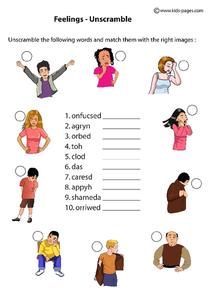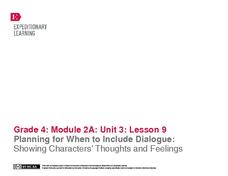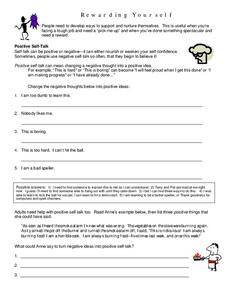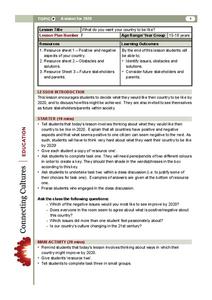Kids' Pages
Feelings Fill In
How does it feel when you don't get your favorite toy? Explore emotion words with an exercise that provides pictures and descriptions of people in different situations. Kids choose from a word bank to fill in the blanks for people who...
Missouri Department of Elementary
My Feelings
Encourage self-awareness with a lesson that challenges scholars to identify feelings—happy, sad, mad, and scared. Using a feelings thermometer, similar to that of a bar graph, pupils discuss how they would feel in specific scenarios then...
ESL Kid Stuff
Feelings & Emotions
Sometimes it can be hard to express emotions. Help little learners figure out what makes them happy, angry, sad, or scared with a lesson that focuses on feelings. It includes singing, drawing, matching flashcards, and more.
Kids' Pages
Feelings/Emotions Matching
When you are feeling thirsty, you should...go to bed? Using common phrases and clip art images, youngsters practice matching feelings to what their appropriate responses should be.
Kids' Pages
Feelings Matching 2
What does it look like when someone is feeling sad, worried, hungry, or happy? These are some of the emotions that your youngsters will identify in a simple matching activity.
Kids' Pages
Feelings Matching 1
Even subtle differences in facial expressions can give us a glimpse into how others are feeling. Through this visual matching activity, youngsters work to correctly connect 16 feelings to their appropriate facial expressions.
Kids' Pages
Feelings Unscramble
After youngsters have learned about different human emotions, challenge them to unscramble this list of feelings in this learning exercise based on the images provided.
Kids' Pages
Opposite Feelings
Develop critical thinking skills and emotional development with a worksheet, in which learners identify a variety of feelings and their opposites through a matching activity.
Kids' Pages
Feelings Definitions
What is one word to identify someone who cannot think clearly? From confusion and anger to happiness and exhaustion, young learners practice defining basic feelings and emotions by matching terms to their appropriate fill-in-the-blank...
Flourish N Thrive Counseling
A Volcano in My Tummy (Helping Children to Handle Anger)
Sometimes it's hard for kids to express their anger appropriately, or to understand what is happening to their bodies when they feel angry. An insightful instructional activity about anger management can help them identify angry...
Nemours KidsHealth
Stress: Grades 9-12
Everyone feels stress from time to time, but how can you move past it? A seven-page packet of activities guides high schoolers through the process of recognizing and managing their stress. The resource includes discussion topics, a quick...
Do2Learn
Emotional Check-In/Out Worksheet
Encourage learners to develop social skills and build awareness of their own emotions with these check-in and check-out tickets, which allow class members to choose from a list of options to identify and log how they are feeling at that...
EngageNY
Planning for When to Include Dialogue: Showing Characters’ Thoughts and Feelings
Young writers examine dialogue conventions, including indentation, quotation marks, and expressing thoughts and feelings through a fictional text. By noticing where and when authors use dialogue, they decide how to incorporate dialogue...
Curated OER
Picture Fists Full of Kisses
Ease children's back-to-school jitters with this primary grade lesson based on the book The Kissing Hand by Ruth E. Harper. Starting off with a singing of the song "I Wish I Had a Little Red Box", children go on to discuss and create a...
University of Washington
Rewarding Yourself
Everyone experiences negative self-talk from time to time, but how can youngsters learn to take it easy on themselves? Use an activity that focuses on talking positively to oneself, including giving yourself compliments and spending time...
Curated OER
The Anxiety Workbook For Teens
Teens often face a great deal of worry in their lives, and can be at a loss with how to anticipate and handle their emotions. This workbook is an exceptional resource for both educators and students alike as a way of supporting teens in...
Curated OER
Cognitive Triangle Worksheet
What you tell yourself about an event can have a profound effect on what you actually do about it. Encourage learners to examine their thoughts, and how these thoughts eventually translate into feelings and actions, with a worksheet that...
Project B.A.S.I.C. Child Development Specialist and Child Care Consultation
Better Attitudes and Skills in Children
Little kids often have very big feelings, and need help expressing them. A set of social emotional lessons provide tangible ways for young elementary learners to visualize their emotions, focus on clear communication, and channel their...
Learning for Life
Empathy
How would it make you feel if...youngsters learn a valuable life skill in considering how their actions affect other people. They evaluate different scenarios and draw pictures of things they could do to make someone feel better.
ESL Kid Stuff
Subject Pronouns (I, You, He, She, We, They)
How are you feeling? Language learners practice using subject pronouns with adjectives by responding to questions, engaging in games, and singing songs.
Fluence Learning
Writing About Literature: Comparing and Contrasting Characters in Heidi
Scholars read excerpts from the story, Heidi, in a three-part assessment that focuses on comparing and contrasting characters. Each part contains three tasks that challenge learners to discuss, answer comprehension questions,...
Curated OER
The True Confessions of Charlotte Doyle: Graphic Organizer
After completing the first five chapters of The True Confessions of Charlotte Doyle By Avi, use direct quotes to make inferences about how Charlotte feels about certain characters. Later, when the novel has concluded, revisit the text to...
University of the Desert
How Do I Feel That My Culture Is Misunderstood by Others?
Using video clips of young adults from around the world describing their cultures and how they can be misunderstood, learners compare their own cultural point of view to that of others through discussion and writing.
University of the Desert
What Do You Want Your Country to be Like?
How would you like your country to be by 2020? What issues do you feel are most important, and how do those compare with your peers? Learners tackle questions regarding the evolving national and global culture of the twenty-first century...
Other popular searches
- Feelings and Emotions
- Feelings Thermometer
- Feelings Emotions
- Expressing Feelings
- Feelings Collage
- Era of Good Feelings
- Character's Feelings
- Feelings Lesson Plans
- Character Feelings
- Positive Feelings
- Feelings and Emotions Chart
- Beginner Esl Feelings

























